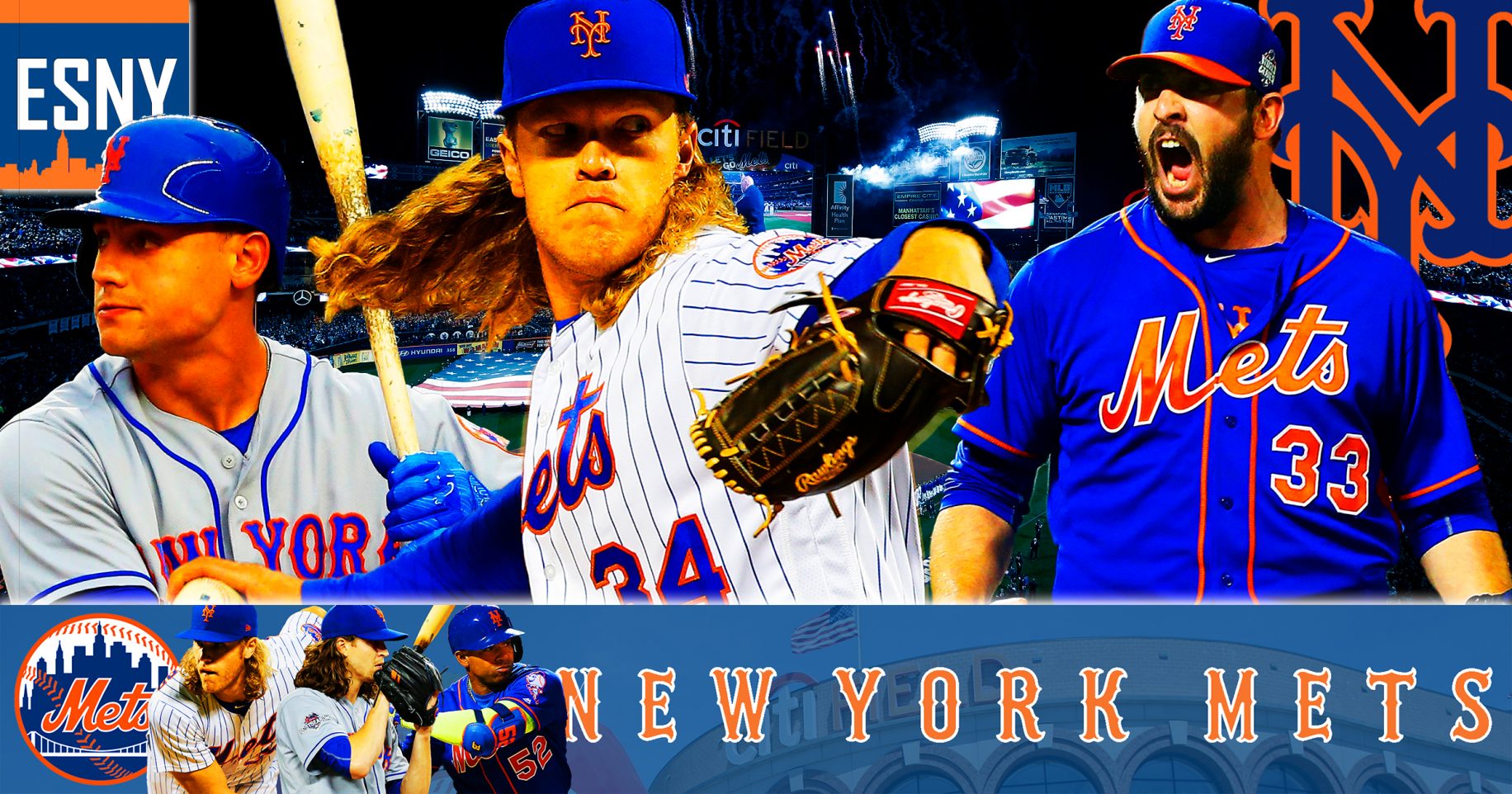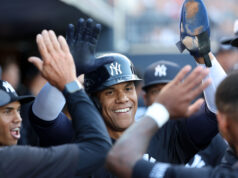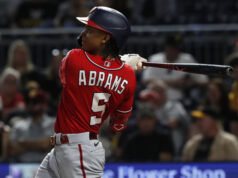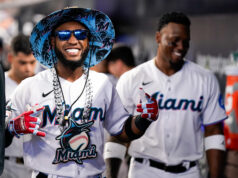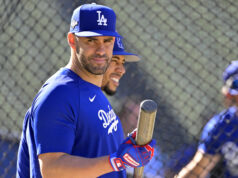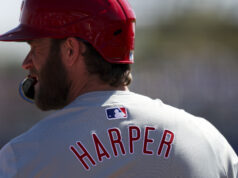Because of Yoenis Cespedes, the New York Mets have the Dodgers on the verge of elimination. But what if New York had Carlos Gomez instead?
By Bryan Pol
 Last night, Matt Harvey had the perfect opportunity to galvanize his legacy as postseason hero for the New York Mets, and for the most part, he blew it.
Last night, Matt Harvey had the perfect opportunity to galvanize his legacy as postseason hero for the New York Mets, and for the most part, he blew it.
Harvey, taking the mound for the Mets’ first postseason action ever staged at Citi Field, had much difficulty locating his pitches, which resulted in a three-run inning for the Dodgers in the top of the second, by which Los Angeles mustered four hits, their third run coming as a result of Curtis Granderson error and Harvey’s inability to back up Granderson’s wayward throw to third.
Granderson would more than compensate for his miscue, amassing five RBI in total, including three on a two-out, bases clearing double that provided Harvey a one-run advantage heading into the top of the third.
A thing of beauty. #BatFlip #Epic #Mets #LGM @ynscspds pic.twitter.com/ucWIlxlCNQ
— New York Mets (@Mets) October 13, 2015
In all, Harvey was neither horrid, nor was he great, nor was he nearly as convincing as Jacob deGrom, who tied a Met postseason record for a starter with 13 strikeouts in Game 1. Over five innings, Harvey yielded three runs (two earned), seven hits, and two walks while striking out seven.
Despite his issues with the strike zone, Harvey did end up earning the win, and even begged incessantly to return to the mound to pitch the sixth, giving fans and media reason to believe he will not be slave to a phantom innings count imposed by agent Scott Boras. Regardless of Harvey’s performance and pleas, the 13-7 Mets’ win was very much garnered by their bats, especially that of Travis d’Arnaud’s and Yoenis Cespedes’s, both of whom homered on Monday night.
[su_youtube_advanced url=”https://www.youtube.com/watch?v=IqFFzDjlgI8″]Prior to the trade deadline, the Mets fielded the worst offense in the major leagues, often times forced to play minor league quality, replacement-level players (John Mayberry, Kevin Plawecki, Anthony Recker, and Eric Campbell) when the likes of David Wright, d’Arnaud, and Michael Cuddeyer were injured for extended spells of time. While Sandy Alderson’s trading for Juan Uribe and Kelly Johnson, super utility players at this point in their careers, was enough to provide depth and added spark to the Mets’ lineup (both were hitting above .270 at the time of their making way for Flushing), New York was several pieces away from providing a product worthy of a thrilling pitching staff that kept the club within mere games of the top spot in the NL East.
Days before the non-waiver trade deadline, with Johnson, Uribe and Tyler Clippard, fulfilling a set-up role vacated by Jenrry Mejia and his PED suspension, already aboard, Alderson was working out a deal that would have sent homegrown infielder Wilmer Flores and Zack Wheeler, he, a one-time deadline deal that sent fan favorite Carlos Beltran to San Francisco, to Milwaukee in exchange for former Met prospect Carlos Gomez, who excelled in several seasons as the Brewers’ centerfielder.
Prior to the aforementioned deadline, Alderson’s hand was forced to call up hot outfielding prospect Michael Conforto, who was laying waste to the Double-A and Triple-A ranks with his lively bat. In a mere 174 at-bats since the promotion, Conforto played valiantly, hitting .270 with 9 homers and 26 RBI, finishing eighth on the Mets in Wins Above Replacement (2.1), just below Yoenis Cespedes (2.3), acquired at the zero hour of the non-waiver trade deadline, when the Gomez deal unceremoniously fell through, causing strife amongst the fan base for the organization’s relative ineptitude and mishandling of Flores, who became a member of the Mets at age 16, New York being the only organization he had ever known.
The strife lasted for the briefest of moments, as Flores, who stayed in Flushing, performed tremendously on deadline day, capping an extra innings affair with a walk-off blast that felled the Nationals 2-1.
[su_youtube_advanced url=”https://www.youtube.com/watch?v=UmL4rNYmJ9U”]Flores’s heroics, arguably the turning point of the season, was buttressed by what Cespedes has done for the Amazin’ Mets since his Saturday debut with them on the afternoon following Flores’s walk-off homer. The slugger by way of Cuba almost singlehandedly turned the Met offense into the best lineup in the majors after the All-Star Break, boosting the club to nearly two runs scored better per game (on average) than the team’s first half offense. While the eventual returns of d’Arnaud and Wright, the call up of Conforto, a clean bill of health from Lucas Duda, and the season-long consistency of Daniel Murphy and Curtis Granderson did their part to bolster the lineup, Cespedes was the man who manifested into the Mets’ stalwart in times good and times bad. Undoubtedly, the Met offense lives and dies on the success of Cespedes’s bat.
A perusal of Cespedes’s statistics illustrates a season and stint of glory that is almost Ruthian by Met standards.
- Cespedes’s coming out party occurred at Coors Field on August 21: that night against Colorado, he went 5-for-6 with three homeruns and seven RBI, prompting comedian and Met diehard Jim Breuer to provide his most memorable Met post-game video yet.
- In a three-game sweep of the Nationals on the road in early September, Cespedes went 6-for-14 with two homers, four runs scored, and seven RBI, a collective three-game effort that gave the Mets a 5 1/2 game edge in the division, a lead they would not relinquish en route to winning the National League East by seven games over Washington, the team’s first division title, its sixth ever, in nine years.
- In September and October (the regular season), Cespedes was practically a demi-god: his triple slash line was .300/.345/.673, good for an OPS of 1.017. His 74 total bases were the most in any month for Cespedes all year. His nine home runs in this time span were also the most of any month in 2015, and his 21 RBI were the second most in any month other than August, by which, in having first joined the Mets, he totaled 23 RBI.
- He ended his Met tenure in the 2015 regular season with 17 home runs and 44 RBI, and his total of 35 homers and 105 RBI were career highs, remarkable considering he regularly hit in not one, but two cavernous ballparks: Comerica Park in Detroit and Citi Field in New York.
- Without question, Cespedes’s 2015 campaign, off the strength of his magnificent stint in New York, has made the Cuban star a $15 to $20 million a year player, and he has even given the Mets time beyond the World Series, when his contract stipulated he would officially become a free agent, to negotiate a contract first before he attempts free agency.
In three games in the NLDS, Cespedes has not at all fizzled. He opened the Met scoring in Game 2 with a shot off Zack Greinke, enjoying an historical season, and extended New York’s lead in Game 3 with a massive three-run shot, giving the Mets a 10-3 advantage. Already a postseason star with Oakland—he hit .349 with one homer and six RBI in 40 at-bats with the Athletics over two separate postseasons—Cespedes is chugging right along with New York, hitting .333 with two homers, four RBI, and four runs in 12 at-bats. When he hits well and sees the ball, his performance has a trickle-down effect on his teammates, who see better pitches because of Cespedes’s immense prowess.
And what of Carlos Gomez, who went to the upstart Houston Astros instead of New York? In 41 games and 149 at-bats with Houston, some of which were tainted by various ailments and injuries, Gomez hit .242, 18 points below his season average, and a far cry from the the .284 average he sustained in his two All-Star seasons, 2013 and 2014, with Milwaukee. His OPS+ with Houston was 83, well below an average player’s worth of 100, and he does not run with the same speed, frequency, or gusto with which he was once capable in first playing for the Brewers.
In fact, Gomez’s presence in the lineup did very little to bolster Houston’s chances, as they lost their division lead to the Texas Rangers, and needed a play-in game, on the road against the Yankees, just to make the ALDS. While such faltering can be attributed to the lackluster performance of midseason acquisition Scott Kazmir, Mike Fiers’s inability to repeat his numbers with Milwaukee, from whom the Astros received in the Gomez deal, and the slight decline of ace Dallas Keuchel, Gomez’s so-so performance is at the very least an attributing factor. Place Gomez on the Mets in lieu of Cespedes, however, and New York, quite frankly, does not garner a spot in the postseason. That is how important Cespedes is to these New York Mets now and going forward. Lest we forget, Met fans initially grieved over not landing Gomez.
Over two months later, with Cespedes serving as the franchise’s relative savior, those same fans are savoring the memories Cespedes has provided in what has turned out to be a magical run, one that will not end any time soon for as long as Cespedes is there to provide dynamics and fireworks off the clout of his mighty, October-ready bat.
[su_button url=”https://elitesportsny.com/2015/10/13/new-york-mets-take-out-the-paddle-to-the-dodgers-in-game-3/” target=”blank” style=”flat” background=”#000080″ size=”10″ wide=”yes” center=”yes”]NEXT: Mets Take Out The Paddle To The Dodgers In Game 3[/su_button]

